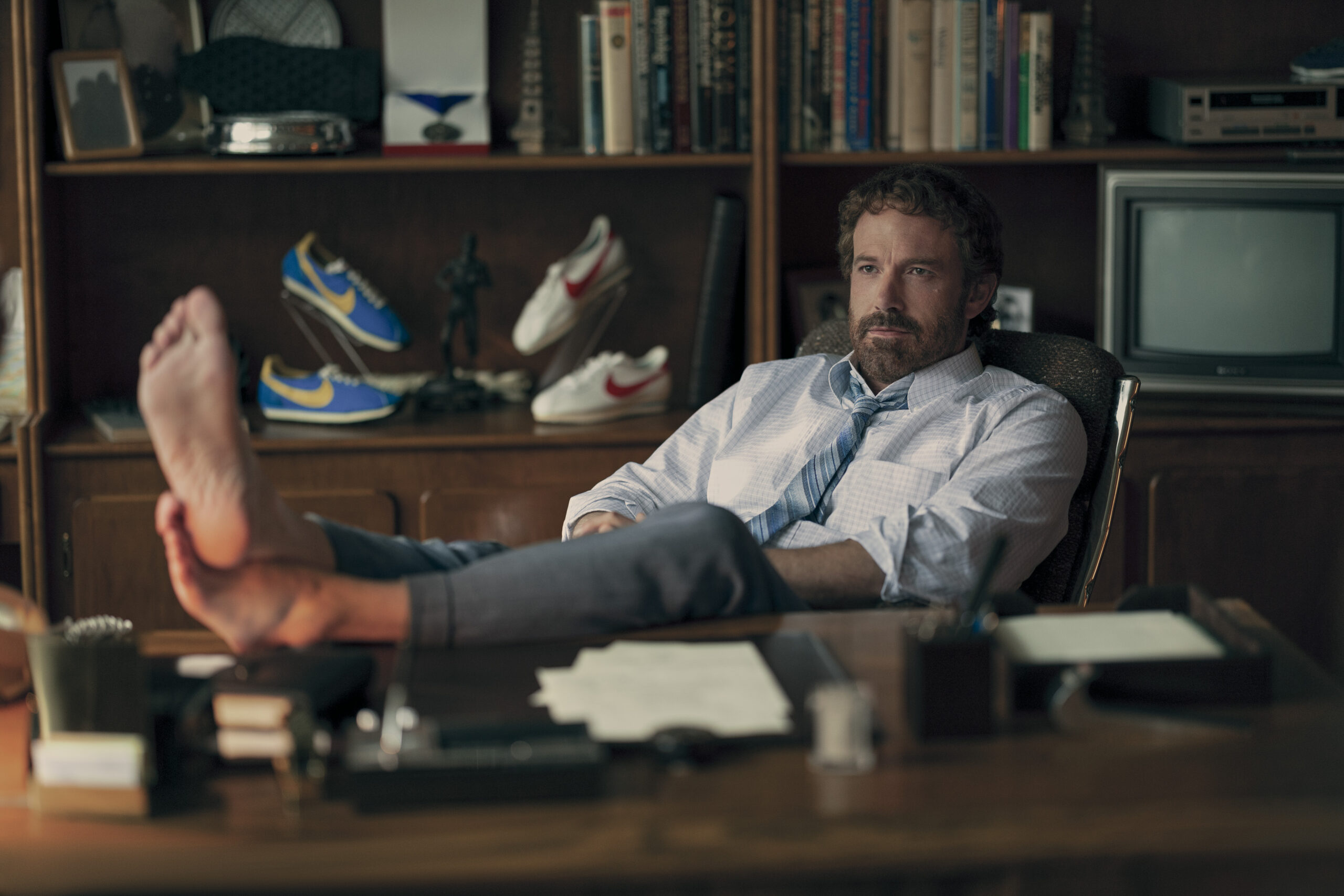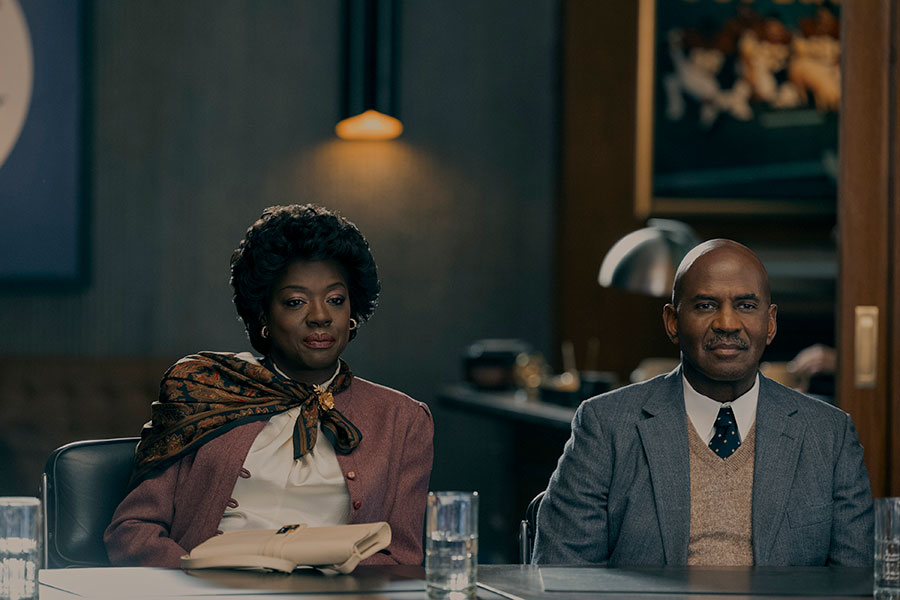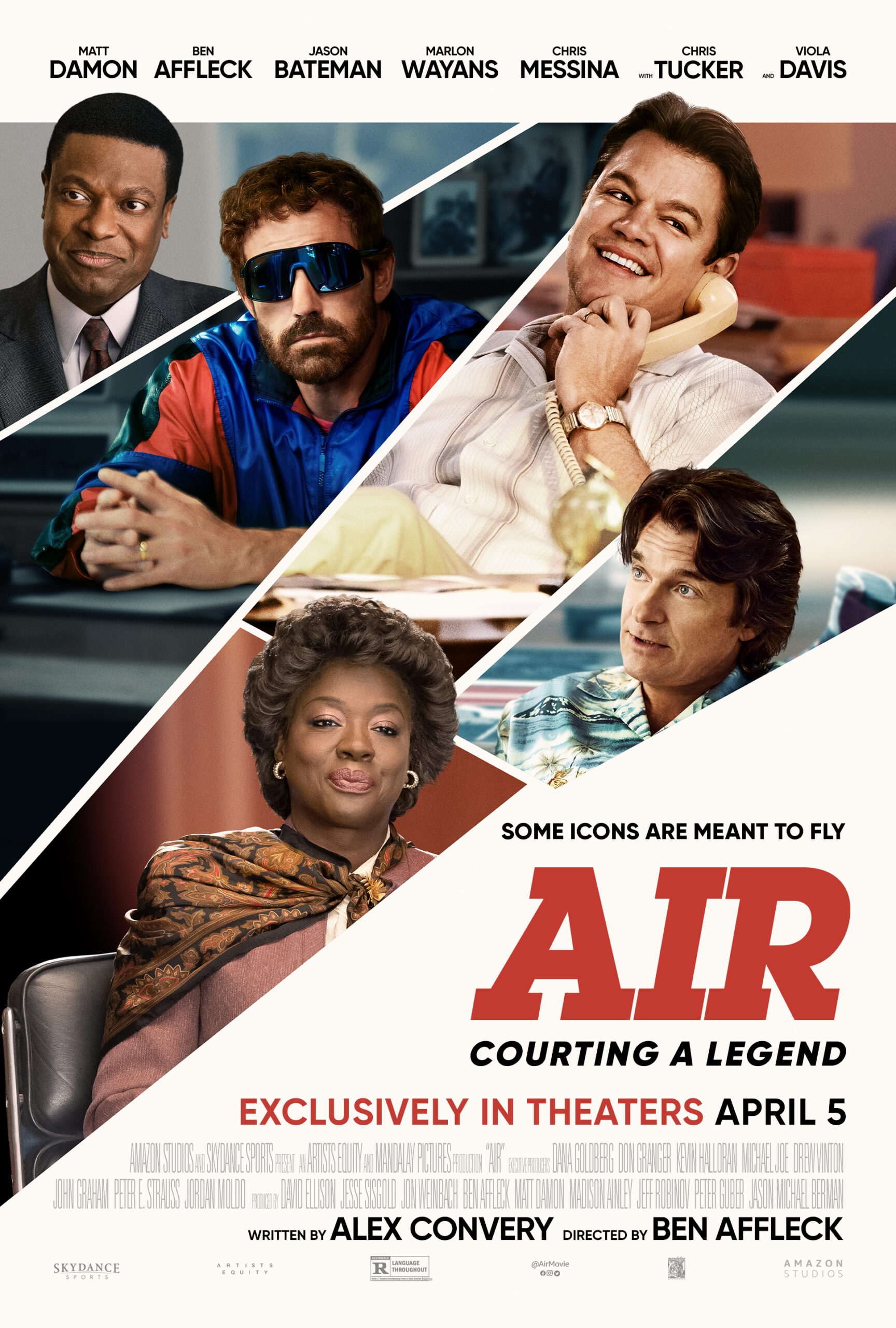Ben Affleck’s ‘Air’ Brings (Some of) the Michael Jordan-Nike Shoe Story to the Big Screen

Michael Jordan executing a signature slam dunk in 1988. Photo: Bettmann/Getty Images. Inset: Detail of the Air Jordan Nike shoes worn by Jordan, circa 1985. Photo: Focus on Sport/Getty Images
Last December, the Jordan Brand opened up a flagship store in Milan called World of Flight. The lucrative US$5 billion a year Nike footwear division, whose 1984 origin story is now dramatized in the new Ben Affleck movie Air, designed the storefront with local Milan artists like Stefano Summo to celebrate the culture and iconography that was carefully built into — and then subsequently born from — the most groundbreaking shoe deal in history.
Those Jumpman-emblazoned sneakers, made to appeal to inner-city kids hanging out at basketball courts and beyond, have come a long way. Think of the Nike x Off-White by late Louis Vuitton designer Virgil Abloh or the Dior x Air Jordan line by Kim Jones. Jordans have elevated basketball sneakers from the court to couture, which is why they have a brand-new shrine in the fashion capital of the world.
The movie Air, which Affleck, 50, directs, doesn’t depict how the world’s most iconic basketball shoes travelled to Milan, taking Black culture with it. Nor does it delve too deeply into the exploited labour in sweatshops producing Nike’s billion dollar product, or Jordan’s apolitical stance and outspoken refusal to chime in on issues, even when they affected the Black community, because in his words “Republicans buy sneakers, too.” That’s a big story with enough nuances, complications and intricacies that could spread eagle across episodic television. Affleck’s respectful, soft-around-the-edges movie can only make gestures towards that.

Air is sequestered mostly to offices and boardrooms and follows the worker bees at Nike’s basketball division who, in 1984, decided to go all in on a branding deal with then-rookie Michael Jordan. Affleck’s bestie Matt Damon stars as Sonny Vaccaro, the talent scout who pesters Nike’s co-founder Phil Knight (Affleck) to trust his instincts that Jordan, who is never seen on screen, will be worth every penny. The movie tells that story with the same buzzer-beater intensity you’d expect from a championship game.
The reach and impact of the shoes is there beyond the edges of the frame, counting on the audience, who are watching a story told in retrospect, to know exactly what comes next and rewarding our basic recognition.
The Aaron Sorkin-esque banter throughout the movie clues us in to some of the stakes involved. Nike was primarily a running shoe company catering to the largely white demographic who go jogging. Jordan, at the time, preferred to sign with Adidas, which was already hip in hip-hop culture among b-boys and break dancers. The iconic Run DMC song “My Adidas,” which would prompt hip hop’s first brand deal, wouldn’t drop until 1986, though that doesn’t prevent Affleck’s Air from referencing it two years prematurely.
Converse dominated the basketball shoe market at the time with Magic Johnson, Larry Bird and Julius Erving all signed to the brand. But none of those iconic players had a shoe at Converse designed specifically for them. They were ambassadors for the brand, wearing whatever Converse models were in stock. Nike won by designing shoes specifically for Jordan’s feet and ego, realizing that they were boarding his brand of excellence before it took flight.
Affleck’s movie gets that. Damon’s Sonny Vaccaro makes the point during a spiel about the shoe just being a shoe until Jordan steps into them, a point reiterated back during a key negotiation scene by Viola Davis, who plays Jordan’s mother, Deloris. Having Davis, who regularly advocates with passionate speeches about respecting self-worth, deliver the final lines about Michael Jordan’s value, is so tactical it’s transcendent.

The movie, however, merely touches on how rule breaking the shoes were. The Jordan 1s are red and black, reflecting the Chicago Bulls colours. Their design defied NBA regulations, which stipulated that shoes must be uniform white, so that no player stood out from their teams. The NBA, like so many governing institutions, wanted players to fall in line. But the power of Air Jordans was their individualism. They were a reflection of a standout player who would soar above everyone else. That meant defying the NBA rules. Nike paid the fines that Jordan would face for wearing banned shoes, while working that story into their marketing.
There is a key ingredient that made Air Jordans the most coveted product to ’80s and ’90s kids from all economic backgrounds, but particularly for the teenagers from urban areas to whom the shoes were initially marketed. The rule breaking sneakers represented excellence and defiance, aspiration and rebellion. They were, in spirit, very hip hop.
The musical genre and cultural style born from hardship in the Bronx, Queens and Brooklyn was all about aspiring for greatness with a defiant attitude. It’s no coincidence that hip hop and Jordans would ascend together, both dominating and feeding off each other in the ’90s and beyond.

Nike carefully played into that association early on with a brilliant marketing strategy to launch the Air Jordan 3, when the infamous Jumpman logo, a silhouette of a Black man reaching for the sky, was introduced. The campaign aligned Michael Jordan with Spike Lee, a defiant up-and-coming Brooklyn filmmaker oozing hip hop’s aspirational energy. Lee resurrected his She’s Gotta Have It character Mars Blackmon in a series of commercials where he covets Air Jordans and drops the iconic line, “Money, it’s gotta be the shoes.”
The Jordans in turn would play a role in Lee’s timeless masterpiece, Do the Right Thing, in a scene where Giancarlo Esposito’s Buggin Out stays true to his name when a man wearing a Larry Bird jersey scuffs his precious sneakers.
When Spike Lee finally took the Academy Awards stage in 2019 to accept the Oscar for his BlacKkKlansman screenplay, he was wearing a pair of custom gold metallic Jordan 3s commissioned by Jordan himself and designed by Nike’s Tinker Hatfield.
Taking basketball sneakers to the Oscars is no more out of place than wearing them to the presidential inauguration, as Nikolas Ajagu did when he sported the Dior x Air Jordan 1s while his wife’s aunty, Kamala Harris, was sworn into office as vice-president in 2021.
Jordans have soared far beyond the basketball courts, enjoying the rarified air of high fashion. Some are sold and then resold for tens of thousands of dollars at Sothebys. Others sit in a storefront in Milan.
That journey makes these shoes worth their own movie, even if that movie leaves most of their story floating somewhere off the frame.
RELATED:
What LeBron James Setting the All-Time NBA Scoring Record Means in the Enduring GOAT Debate
Tom Brady Retires: How the NFL’s Greatest Quarterback Revolutionized the Way We View Older Athletes
#NikeBoycott Puts Spotlight Back On Colin Kaepernick’s Misunderstood Protest